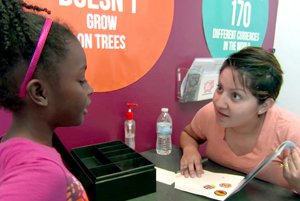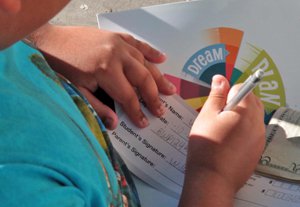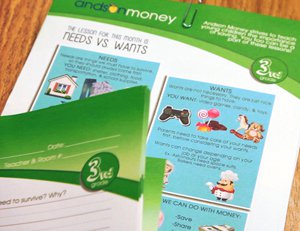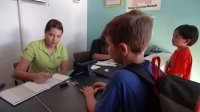Financial Literacy From Age 5 On
Elementary students study saving, spending, and sharing on the way to putting a collective $30,000 in the bank in a year.
Overview
Through Piggy-Bank Friday, K-5 students at Walter Bracken STEAM Academy, a Title 1 magnet school in urban Las Vegas, Nevada, build the habit -- and learn the importance -- of saving money. They set up a real bank account, make weekly deposits with bankers at their school, track their balances, and receive monthly financial literacy lessons.
When fifth-grade students leave Walter Bracken, their accounts are closed, and they have the option to either cash their savings or open a new account with Silver State Schools Credit Union (SSSC). "I've never heard a kid say, 'I'm going to spend it,”' says Katie Decker, Walter Bracken's principal.
Bracken students saved $15,000 two years ago and over $30,000 last year. "This year, each weekly deposit has been averaging close to $2,000, so we're going to exceed what we did last year," adds Decker.
How It's Done
Partner With Your Local United Way
Walter Bracken STEAM Academy partnered with United Way's Young Philanthropists Society (YPS), who developed the Piggy-Bank program at Bracken and have since expanded it to two other elementary schools in Nevada’s Clark County School District and are also working with a school in Florida.
United Way connected Walter Bracken administrators and teachers to:
- A local bank, Silver State Schools Credit Union
- Andson Inc., a nonprofit that developed the financial literacy curriculum
- Volunteers who donated their time and the materials to build an on-campus bank at the school site. They turned a janitor's closet into a bank teller counter and created decals for the walls with advice on how to save money.
"I wouldn't do this program by myself," emphasizes Decker. "You need a bank, and you need United Way. We don't want to handle the children's money because that just could go awry. It's best to have a partner."
Partner With a Bank

A Silver State Schools Credit Union representative comes to Walter Bracken, and each participating student opens an account with them at the beginning of the year. Krupa Kothari, the former business development coordinator at Silver State Schools Credit Union, advises partnering with a credit union rather than a bank.
She says that a credit union is an ideal partner for teaching financial literacy “because it's people within their own city that are supporting this financial institution, and it's on a smaller scale.” She notes that smaller-scale financial institutions can easily coordinate something like this, adding, “We're managing 300+ accounts for students. We want to give every single student that opportunity."
Manage Piggy-Bank Friday
Gain Parent Permission
Walter Bracken sends a letter home to their students' parents, letting them know about the program. Parent permission is required for students to participate, just as it would be required for a minor to open an account with any bank. Parents need to fill out and sign their child's deposit book, and they are required to sign each deposit slip, acknowledging that they know how much money their child is depositing each week.
Give Your Students Their Banking Materials

Each student gets a deposit book to track their savings, deposit slips (PDF) to make their deposits, and a deposit bag to hold both, as well as a piggy bank to save their money over the summers. Stewardship over these materials empowers financial awareness and an authentic involvement in the process. "They're tracking every single deposit that they're making. They know what their current balances are, and they also have a goal that they've written down," says Kothari.
Gather Volunteers
Initially, representatives from United Way, Silver State Schools Credit Union, and Andson Inc. volunteered their time each Friday to run the school bank as tellers. This year, Andson is providing the tellers. When the same teller returns each Friday, he or she gets to know the students and nurture relationships with them.
United Way and SSSCU still volunteers each Friday. While students are waiting in line to deposit their money, the volunteers review financial literacy concepts with them. For example, they discuss short- and long-term goals, and the difference between instant gratification with saving money for a toy and the longer-term gratification that comes with saving money for a computer, a car, or college.
Collect Weekly Deposits
Students can deposit their money -- even just a penny -- before or during school. Before school, they can come on their own or with their parents to make a deposit. The bank tellers open their door each Friday 30 minutes before school starts. During the school day, students make deposits with their class, one classroom at a time, as scheduled by the administration.
When students come to deposit money, the tellers:
- Check that the deposit slip is filled out correctly
- Deposit the money and stamp their deposit slips
- Ask about their long- and short-term goals
- Give them a sticker, acknowledging their deposit, and congratulate them
"They get to track every deposit in their registry," says Kothari. “They know that, if they continue making those individual two-dollar deposits, they’ll eventually get to their hundred-dollar goal at the end of the year.”
Once all the money is collected each week, someone from SSSCU picks up the deposits from the school, or a United Way fiscal agent brings the money to a SSSCU branch.
Develop Your Curriculum

Walter Bracken’s monthly financial-literacy lessons focus on:
- Needs vs. wants
- Long-term and short-term goals
- Budgeting
- Smart spending
- Banking
Andson Money, a subset of Andson, developed their curriculum specifically for Bracken's Piggy-Bank program, taught it to their students, and then integrated feedback from teachers to ensure that it tied into ELA, math, and national standards for financial literacy.
"It started out where we had a few different lessons, and now we actually have a differentiated lesson for every grade," says Anthony McTaggart, the chief operations officer and cofounder of Andson.
Teach Monthly Lessons
Every four to six weeks, an Andson instructor comes to teach a lesson. Needs vs. Wants is the first lesson for K-5. In this lesson for third-grade students, the instructor introduces a scenario: Students will be stranded on an island, and they can only bring six things to help them survive. In small groups, they receive a deck of cards with a picture and the name of an item on each card (like a saw, candy, medicine, a television, or clean water), and discuss which items they're going to bring with them.
By the end of the lesson, students realize that they only need a few essential items to survive. When they discuss their homework with their parents, says McTaggart, "they're identifying what their needs or wants are for their family and life, and it's inspiring to see that students are able to say, 'Well, this is just a want right now. Let's do away with this, and let's focus on what our needs are.'"
Your Role as a Teacher
Piggy-Bank Friday is heavily partner-involved, but the success of the program depends on teachers. If teachers don’t lay the groundwork for the partners who will teach the financial-literacy lessons, if they don't remind their students to bring in money to deposit on Fridays, and if they don't brainstorm ideas with their students on how to earn money, then it won't be successful. The teachers' role is to encourage, support, and get their students excited about saving money.
"You need school buy-in to start anything," says Anna Hurst, Walter Bracken's assistant principal. "You need the whole community to be a part of it."
